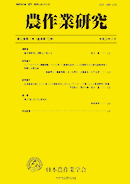All issues

Volume 52 (2017)
- Issue 4 Pages 149-
- Issue 3 Pages 121-
- Issue 2 Pages 57-
- Issue 1 Pages 5-
Volume 52, Issue 3
Displaying 1-3 of 3 articles from this issue
- |<
- <
- 1
- >
- >|
Original Paper
-
Hayato Shindo, Masanori Saito, Keiji Sasaki, Yuko Sato, Mitsuhiko Kata ...2017Volume 52Issue 3 Pages 121-131
Published: 2017
Released on J-STAGE: March 20, 2018
JOURNAL FREE ACCESSWe studied non-puddling direct rice seeding into flooded paddy field soil, which uses a seedbed produced with a chisel plow and a power harrow, with seeding by a precision direct drill seeder. Those methods apparently improve spring work related to rice direct seeding, such as tillage, harrowing, and puddling. Therefore, we investigated the work rate and fuel consumption of spring work, rice growth, yield, and brown rice quality. These data of non-puddling direct rice seeding cultivation (NP) compiled during 4 years were compared with those obtained from conventional tillage cultivation (CT). Seedbed preparation work using a chisel plow and power harrow achieved 63.4–73.5% soil pulverization ratios. The precision direct seeder can sow into non-puddled soil 3–4 days after flooding softens the soil. Seedbed preparation work time and fuel consumption in the NP block were decreased respectively by 41% and 26% compared to the CT block. The NP block seeding establishment rate was 71.7% on average, which was higher than that of CT block. These test blocks showed sufficient seeding establishment. The NP block showed faster midseason drainage for soil moisture, with a higher percentage of the productive culms and lower generation of non-productive tillers, with an equal or greater number of panicles than the CT block.View full abstractDownload PDF (1326K)
Research paper
-
Toshiyuki Hirata, Daisuke Noguchi, Hajime Araki2017Volume 52Issue 3 Pages 133-142
Published: 2017
Released on J-STAGE: March 20, 2018
JOURNAL FREE ACCESSThis study examined how hairy vetch seeding affects reduction of nitrogen (N) fertilizer application to the continuous cropping of spring wheat in Central Hokkaido, in 2015 and 2016. The spring wheat cultivar, ‘Haruyutaka’, was cultivated using two cropping systems, namely, a conventional system wherein spring wheat was sown in early April and an early winter seeding system wherein spring wheat was sown just before snowfall. Hairy vetch was grown until just before the spring wheat seeding was completed in the conventional system. In contrast, in the early winter seeding system, hairy vetch was incorporated in late October. N fertilizer application after snow melting was reduced to half the recommended level in the cropping systems employing hairy vetch. Growth and dry matter production in spring wheat were estimated in 2015 and 2016, by comparatively evaluating these results with the conventional and the early winter seeding systems without hairy vetch application. Dry weight of hairy vetch ranged from 250.1 g m-2 in the conventional system in 2014 to 50.1 g m-2 in the early winter seeding system in 2015. The grain dry matter weight was higher in the early winter seeding system in only 2015, but there was no difference between hairy vetch application treatments in both systems in 2015 and 2016. N content in wheat grain ranged from 2.29% to 2.52%, which was sufficient to ensure seed quality of spring wheat. The plant length was suppressed at the late growth stage in the early winter seeding system employing hairy vetch in 2016. This results suggest that N deficiency occurred at the ripening stage of wheat in this system. The present study shows the potential to reduce spring N fertilizer to half of the recommended level by introduction of hairy vetch during the previous autumn season.View full abstractDownload PDF (945K)
Information
-
[in Japanese]2017Volume 52Issue 3 Pages 143-144
Published: 2017
Released on J-STAGE: March 20, 2018
JOURNAL FREE ACCESSDownload PDF (1323K)
- |<
- <
- 1
- >
- >|